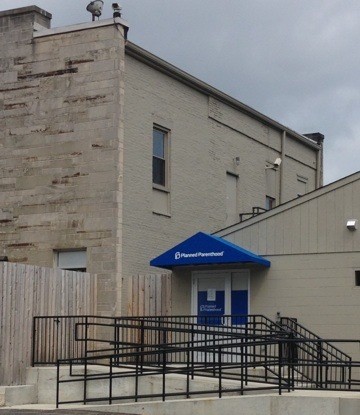The clipping noted below, written Agnes McCulloch Hanna, was published in an undated, unsourced Bloomington newspaper under a column called “Looking Back.” It was found in a scrapbook compiled by a man named Fred Lockwood. The scrapbook is held by the Monroe County History Center, Bloomington, Indiana. The item below was abbreviated from the original, as noted by the ellipsis, and excludes information pertaining the Maxwells’ involvement with the authorship of Indiana’s constitution and Indiana University.

The bricks for the old Joshua Owen Howe home in Bloomington were brought from Louisville, Ky., although stone lay just under the grass of the building site. The pioneers of Monroe County knew nothing of the wonderful material within their reach, and when they were ready to replace the early log structures, they sent for brick that as baked in distance kilns. These in this simple, dignified house on South College Avenue were among those brought from Kentucky.
Joshua Owen Howe came to Indiana and the village of Bloomington in 1819 and became a leading merchant. His people had come to Ellicots Mills in Maryland before the revolutionary war and were manufacturers there. In Bloomington he built his first cabin and store on the public square and cleared away great trees and underbrush that the townspeople might have easy access to his store. He lived there some 15 years. Then, having made a success of his ventures, he decided to build a new and larger home near the college. He bought a plot of ground and built the house which stands today much as he built it, although it is possible that the bay windows were later additions.
The house is three stories high. The woodwork is painted white with the exception of the doors which are cherry. The treatment of the massive window casings is unusual. All the carving and grooving is handwork. In the ceiling the plaster is indented to correspond, a means of decoration not seen before. The inside, folding shutters belong to the period.
Ten great fireplaces were in the house in the early days. They were replaced by stoves later and then by radiators. Three fireplaces are still in the house. Mrs. Allan B. Philputt of Indianapolis, one of the granddaughters of the Howe family, says that the fireplace in the south room had a very high mantel piece which was so tall that it was difficult to reach for dusting. In that sunny room Louisa “Dovie” Howe, Mrs. James Darwin Maxwell, could be found most of the hours of her busy life. The sun poured in there through the bay windows and the fire gave wonderful warmth to the babies who were rocked in the little, old rocking chair and to the older children who brought to her their troubles and joys. There she sat to mend for her children and to wait for her busy, physician husband who was riding horseback through the country on his long calls or was busy with the affairs of the new state college for which he was resident trustee. The college was a near neighbor to the Maxwell house.
The center halls of the house are wide and high. The circular staircase is the most interesting feature with easy ash treads, and the handmade bannister. The lower hall leads from the recessed front door with its silver luster bell pull to the series of rooms built at the rear, the kitchen, pantry, wash and wood houses. A brick pavement outside the last rooms had in it two cisterns called the “summer” and the “winter.” Even in those early days the infrequent rainfall was carefully conserved in Bloomington. The [American] Legion post which now owns the house has thrown two rooms together and uses the pantry as kitchen.
In 1843, Dr. James Darwin Maxwell, son of Dr. David Hervey Maxwell and Mary Dunn, married Louisa “Dovie” Howe in this house. The only bridesmaid was Jane Nowland, youngest daughter of Matthias R. Nowland of Indianapolis. Miss Nowland made her home with the Howe family while she attended the female seminary.
Ten children were born to the James Maxwell, and in spite of the fact that the grounds about the house were large and that through them ran a brook, Mrs. Maxwell said that when each of her four boys brought a companion to play and the six little girls wanted space for their games, she felt the need of a farm at the very least. So the family went to the country where there was room and to spare. The house they occupied a few miles from town has been made over into two large houses.
When the children were grown they came back to this house. Here Dr. David Hervey Maxwell came to spend his last years. He had been much interested in the development of the railroads, and as a man of vision had hoped to see one come to Bloomington. From whispers and hushed sentences about him, he was convinced that the first train was about to enter the town, and he was ill! When he was left alone on that day in 1854, he got up from his bed, dressed himself and ran across the fields between his home and the tracks and was present at the momentous entrance of the Monon train…
Blog Post by Randi Richardson


Very good work Randi. Thanks.
LikeLike